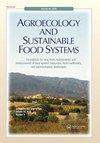结合观察和基于功能特征的方法开发一种多文化设计工具
IF 2.6
3区 农林科学
Q1 AGRICULTURE, MULTIDISCIPLINARY
引用次数: 0
摘要
多样化种植系统中的物种组成模型主要采用基于功能性状或基于观察的方法。我们认为,这两种方法的结合使多元文化设计工具更加健壮。我们评估了来自多个来源的信息的数量、质量和互补性,以便为冷温带气候设计蔬菜和香料作物的多样化种植系统。特征和观测数据来自:(i)两个以种植者为导向的和一个学术作物数据库,(ii)对从事社区支持农业的农民的调查,以及(iii)关于在蔬菜种植中使用香料作物的系统文献综述。调查结果显示,农民能够实现中等至良好水平的主要目标,但未能通过多元文化达到预期的多功能性,这可以通过计算工具进行改进。没有一个分析的数据源提供了所有目标作物和功能性状的全面数据集。然而,来源组合允许从已知的作物伙伴(农民调查和种植者导向的数据库)到解决特定的害虫问题(文献综述)的设计,并通过性状匹配(学术和种植者导向性状数据库)增加功能互补性和便利性。整合来自不同来源的信息增加了作物组合选择的数量,但也增加了规划和管理的复杂性。图形摘要基于功能特征和基于观察的方法在多元文化设计工具中的组合。本文章由计算机程序翻译,如有差异,请以英文原文为准。
Combination of observational and functional trait-based approaches in developing a polyculture design tool
ABSTRACT Models of species composition in diversified cropping systems utilize mostly functional trait-based or observation-based approaches. We argue that a combination of these two approaches makes polyculture design tools more robust. We assessed quantity, quality, and complementarity of information from multiple sources for designing diversified cropping systems with vegetables and spice crops for cold temperate climate. Trait and observational data were integrated from: (i) two grower-oriented and one academic crop database, (ii) a survey of farmers practicing community-supported agriculture, and (iii) a systematic literature review on the use of spice crops in vegetable farming. Survey results reveal that the farmers were capable of achieving medium to good levels of their main goals, but failed to reach desired multifunctionality with their polycultures, which can be potentially improved with computational tools. None of the analyzed data sources provided a comprehensive dataset for all target crops and functional traits. However, source combination allowed for design from known crop companions (farmers survey and grower-oriented databases), to addressing specific pest problems (literature review), and increasing functional complementarity and facilitation by trait matching (academic and grower-oriented trait databases). Integrating information from different sources increased the number of crop combination options but also planning and management complexity. GRAPHIC ABSTRACT Combination of functional trait-based and observation-based approaches within a polyculture design tool.
求助全文
通过发布文献求助,成功后即可免费获取论文全文。
去求助
来源期刊

Agroecology and Sustainable Food Systems
AGRICULTURE, MULTIDISCIPLINARY-GREEN & SUSTAINABLE SCIENCE & TECHNOLOGY
CiteScore
4.80
自引率
7.70%
发文量
73
期刊介绍:
Agroecology and Sustainable Food Systems is devoted to the rapidly emerging fields of agroecology and food system sustainability. By linking scientific inquiry and productive practice with transformative social action, agroecology provides a foundation for developing the alternative food systems of the future. The journal focuses on the changes that need to occur in the design and management of our food systems in order to balance natural resource use and environmental protection with the needs of production, economic viability, food security, and the social well-being of all people.
Agroecology and Sustainable Food Systems examines our current food systems from production to consumption, and the urgent need to transition to long-term sustainability. The journal promotes the study and application of agroecology for developing alternatives to the complex problems of resource depletion, environmental degradation, a narrowing of agrobiodiversity, continued world hunger, consolidation and industrialization of the food system, climate change, and the loss of farm land. The journal uses a food systems approach, and seeks experiences in agroecology that are on-farm, participatory, change-oriented, and backed by broad-based methodologies of sustainability analysis and evaluation.
 求助内容:
求助内容: 应助结果提醒方式:
应助结果提醒方式:


